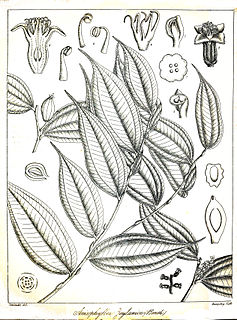
Anacardium, the cashews, are a genus of flowering plants in the family Anacardiaceae, native to tropical regions of the Americas.

Cassia is a genus of flowering plants in the legume family, Fabaceae, and the subfamily Caesalpinioideae. Species are known commonly as cassias. Cassia is also the English common name of some species in the genus Cinnamomum of the family Lauraceae. Species of the genera Senna and Chamaecrista were previously included in Cassia. Cassia now generally includes the largest species of the legume subtribe Cassiinae, usually mid-sized trees.

Zanthoxylum is a genus of about 250 species of deciduous and evergreen trees, shrubs and climbers in the family Rutaceae that are native to warm temperate and subtropical areas worldwide. It is the type genus of the tribe Zanthoxyleae in the subfamily Rutoideae. Several of the species have yellow heartwood, to which their generic name alludes.
Dodecastigma is a genus of plants under the family Euphorbiaceae first described as a genus in 1932. It is native to northern South America.
- Dodecastigma amazonicumDucke - Amazonas State in Brazil
- Dodecastigma integrifolium(Lanj.) Lanj. & Sandwith - French Guiana, Guyana, N Brazil
- Dodecastigma uleanum(Pax & K.Hoffm.) G.L.Webster - Amazonas, Amapá

Sterculia is a genus of flowering plants in the mallow family, Malvaceae: subfamily Sterculioideae. Members of the genus are colloquially known as tropical chestnuts. The scientific name is taken from Sterculius of Roman mythology, who was the god of manure; this is in reference to the unpleasant aroma of the flowers of this genus. Sterculia may be monoecious or dioecious, and flowers unisexual or bisexual.

Macrolobium is a legume genus in the subfamily Detarioideae. It is a tropical genus with about 80 species. Half occur in Brazil, where they are common in the floodplains of the Amazonian Basin. Members of the genus are used as ornamentals and for their wood.

Swartzia is a genus of legume in the family Fabaceae. It was named in honor of Swedish botanist Olof Swartz and contains about 200 species. Swartzia is restricted in its geographical distribution to the New World Tropics, where it occurs primarily in lowland rainforests, but also in savannas, pre-montane forests, and tropical dry forests. While it can be found throughout the wet lowlands from Mexico and the Caribbean islands to southern Brazil and Bolivia, Swartzia is most abundant and species-rich in Amazonia, where 10–20 species may co-occur at a single site. The species of Swartzia are mostly trees, ranging from small understory treelets to large canopy emergents. Some species, especially in savannas, are mult-stemmed shrubs.

Zygia is a genus of flowering plants in the pea family, Fabaceae.

Anisophyllea is a genus of plant in the family Anisophylleaceae. The generic name is from the Greek meaning "unequal leaf", referring to the dimorphism of the leaves.

Esenbeckia is a genus of flowering plants in the rue family, Rutaceae. All species in the genus are native to the Americas, with the highest diversity in South America. They are commonly known as jopoy, the Mayan word for E. berlandieri, or gasparillo (Spanish).

Quiina is a genus of plant in family Ochnaceae. It contains the following species :

Vepris is a genus of plant in family Rutaceae. It comprises around 90 species, mainly from tropical Africa, Madagascar and the Mascarene Islands and at a lesser extent Arabia and India.

Dicymbe is a genus of 20 species of canopy trees in the family Fabaceae, within subfamily Detarioideae. It is found throughout the Guyana Shield region and parts of W Amazonia. Certain species within the genus are strongly associated with ectomycorrhizal fungi.
Clathrotropis is a genus of flowering plants in the legume family, Fabaceae. It belongs to the subfamily Faboideae.

Schnella is a genus of flowering plants in the legume family, Fabaceae. It belongs to the subfamily Cercidoideae. All of its species are neotropical lianas.

Ferdinandusa is a genus of flowering plants in the family Rubiaceae, native to the American tropics.
Neoraputia is a genus of flowering plants belonging to the family Rutaceae.
Zanthoxyloideae is a subfamily of the family Rutaceae.














